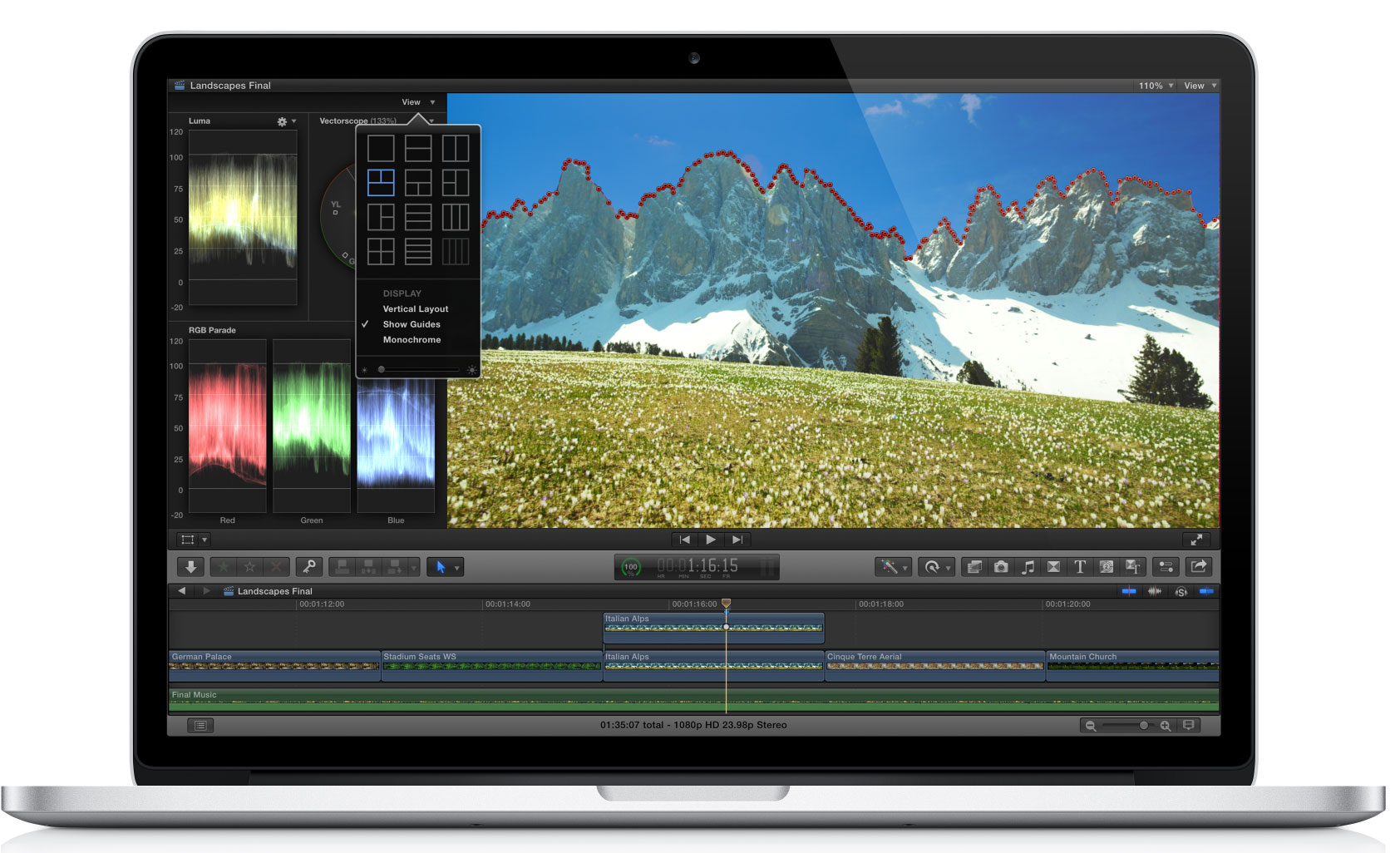
REVIEW: Apple FCP X 10.2
Posted on Jun 19, 2015
Ed Catmull, co-founder and president of Pixar, talks in his book ‘Creativity, Inc.’ about “protecting the new”. When Pixar start planning a new film, it may be that initially it isn’t very good. It’s tempting to axe it, or change it radically, or subject it to some other drastic operation. However, it must be given time to develop, for the characters to find their voices and for the narrative to mature.
I think most people in our industry would recognise this sentiment, though Mr. Catmull’s book expresses and explains the processes more clearly and more insightfully than any other I’ve read. Most creative processes require some aspect of ‘protecting the new’, and software development is no different. Which brings us to Apple’s Final Cut Pro X.
On its release, FCP X undoubtedly met the needs of most of the people in the world who edit video for a living, for instance event and wedding videographers. The vocal minority for whom the initial release wouldn’t work were quick to dismiss FCP X, forgetting that it was new. Perhaps it should have been thought of as needing protection – or at the very least reassessment with each new release.
To coincide with the start of NAB, Apple announced another update to FCP – to version 10.2. The timing of that announcement in itself is an indication that Apple consider broadcast TV and theatrical feature film to be an important market – if not their largest. Version 10.2 (and the more recent bug-fix releases) also show that Apple are listening to their customers – adding useful features and changing awkward or illogical operations.
It’s worth a quick round up of these changes – in no particular order…
 New masks and scopes.
New masks and scopes.
All effects now have masks – both shape masks and colour masks, though the shape masks can’t be tracked, sadly, but you can keyframe them manually. Effects can also be customised and saved as presets (yay – finally!). One sensible side-effect of this is that colour correction is now an effect, rather than an inherent property of a clip, so that it can benefit from these new features. A related new feature is the ability to show up to four video scopes at the same time.
A slightly nerdy, but useful change is Library-level Smart Collections. FCP makes a default set for each Library, but you can delete or change them, and make your own. FCP X’s keywording and collections are excellent – one of the best ways to organise media of any NLE – so it used to drive me nuts that, in previous versions, Smart Collections only worked within an Event.
The Import Window now puts file browsing and import settings in one place, which is much cleaner, and the Optical Flow algorithm has been improved – and it is much better, though it was a bit average to start with.
 3D text and templates.
3D text and templates.
One of the big new features is true 3D Text with extruded, bevelled characters. It’s actually pretty good, with nice textures (though they can go a bit odd on bevels) and good lighting (which can cast shadows on planes but not self-shadowing). FCP X comes with a some templates, which are pretty editable, but you can always open them up in Motion for full control. Apple tout this 3D text as a headline new feature – and 3D text is very lovely – but it’s hardly something you’ll use every day.
There are some performance enhancements as well. Send to Compressor now uses the GPU on compatible machines, as does REDCODE RAW (playback, rendering and transcoding). Compressor will even use your graphics card’s hardware-accelerated H.264 encoding, if it has any.
 Compressor iTunes package.
Compressor iTunes package.
One final, if niche feature of Compressor is automated packaging for the iTunes Store. Before this release, you usually had to pay an iTunes Aggregator to encode and package your movie. Whilst you still have to go through an Apple certified iTunes delivery partner, the technical requirements are now handled by Compressor, which should make the whole process cheaper. Probably.
I’ll admit that I was one of those who looked at FCP X when it was first released and decided was not for me. It didn’t fit into the workflow of the jobs that I do – where sound and picture are both finished in different, dedicated software packages – and there were too many features missing that I rely on. However, it was a new product and I hoped that these issues would be solved in time.
It is now difficult to dismiss FCP X. It’s fast – especially on more modern hardware (see today’s MacBook Pro and iMac reviews) – and at least as stable as its competitors (though some would argue that that isn’t saying much!). It has fantastic media management, good effects, great background rendering and so on. The editing paradigm is, of course, er… unusual, but it’s interesting that the ideas of trackless editing are being applied in other technologies. Object based audio, such as Dolby Atmos, considers each sound as a separate entity, occurring at a time and place in 3D space, much like FCP X’s approach.
Of course, there are still irritations (can I please have the option to put window panels where I want them?) and other NLEs do some things better than FCP X, so the debate will roll on, but with its first major studio feature film under its belt, and increasing deployment in high-end broadcast TV, users are showing that the Pro is back in Final Cut Pro.









